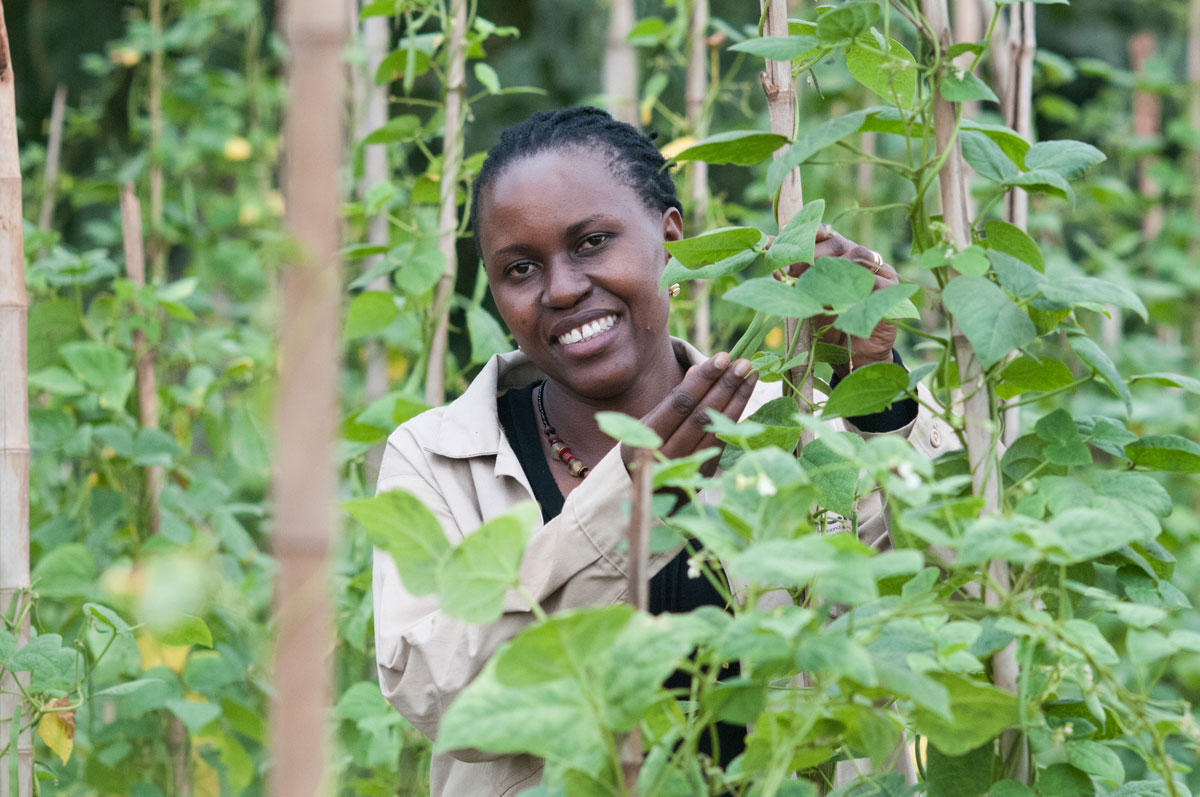Blog Sowing the Future: Africa's lead common bean breeder at the Alliance

Clare Mukankusi joined CIAT in 2003 as a research assistant to Plant Pathologist Dr. Robin Buruchara in the Africa region. She has been with the Alliance of Bioversity International and CIAT for 20 years.
She is currently working as the global lead common bean breeder at the Alliance. This role entails supporting our bean breeding program to develop demand-driven common bean varieties starting from the product design stage to the official variety release. She facilitates the development and implementation of the common bean breeding program strategy, including coordinating the breeding team to ensure the program achieves and sustains genetic gain for key demanded traits; this also involves ensuring that the breeding pipelines are correctly aligned with target product profiles based on farmer’s preference and consumer demands and the target population of environments (TPE).
She oversees the bean breeding program vision and operations across Alliance breeding stations, including implementing improvement plans and using standard operating procedures/guidelines for effective product development. Some of her key responsibilities include engaging with the Bean Program Leader/Director of PABRA together with the research area director for Crops for Nutrition and Health and other related research areas to implement steps towards the modernization of the common bean breeding program in key breeding stages, trait discovery, breeding methodology, high throughput phenotyping, application of molecular tools, mechanization and automation of operations, testing strategies, and data analysis and interpretation.
Claire Mukankusi featured as a hero in the field for the Bill & Melinda Gates Foundation
She also works in collaboration with the market and impact teams to develop and use methods to assess the impact and effectiveness of the bean breeding program. In addition, she also supports the development of training programs to upgrade the skills of plant breeders, support personnel, and partners. A key element of her role is to participate in resource mobilization efforts to drive the bean breeding program modernization at the Alliance and at the national partner level.
Since May 2023, she also serves as CGIAR’s Global lead of the Legumes and forages breeding program in the Global Crop Breeding Leadership team. The mandate of the group is to ensure that all global breeding programs and assets are fit for purpose; provide strategic and technical leadership across breeding networks operating under CGIAR and national agricultural research and extension systems (NARES); foster a culture of innovation, collaboration, continuous learning, and improvement; contribute to resource mobilization and effectively manage resources to deliver the strategy; prioritize development and deployment of specific as well as crop agnostic "platforms" essential for breeding programs, such as data management systems, genotyping, and phenotyping systems and foster global crop breeding team alignment and capacity while establishing and empowering regional CGIAR-NARES breeding networks in the global South.

Interesting facts about Clare:

Mukankusi Clare Tekla Mugisha
Global Breeding Lead-Common BeanWhat are your top 5 achievements in bean breeding so far?
- Initiation of a population improvement program in East Africa based on animal breeding approaches.
- Training of several plant breeding and plant pathology postgraduate students and interns.
- Initiation of the use of the breeding management system (BMS) at PABRA.
- Reviving regional testing in East Africa through ECABYT (ECABREN Bean Yield Trials) and initiating the PABRA regional yield trials (PABRA_YT).
- Pushing forward the bean pathology work at PABRA through participating in disease diagnostic studies on angular leaf spot (ALS), anthracnose, bean root rot, and common bacterial blight; identification of sources of resistance; and mapping distribution of disease hotspots.
What scientist inspires you and why?
I have several that inspire me, and most of these are my academic and professional supervisors, starting with Prof. Adipala Ekwamu, who trained me as a plant pathologist at Makerere University in Kampala, Uganda, and singled me out as a candidate for higher studies to receive a scholarship to pursue a Ph.D. in Plant Breeding. Robin Buruchara mentored me as a professional plant pathologist, introduced me to the partnership model of work at PABRA, and saw me grow into a plant breeder under his supervision. Steve Beebe, from whom I can never stop learning the art of bean breeding. Jean Claude Rubyogo, with his undying passion for the bean value chain, creation of new partnerships and fundraising skills, the excitement of our work, and lastly, Joe Tohme, whose leadership style is soft but firm and respected worldwide.
What are the top 3 challenges of the bean breeding program in Africa?
- Diverse preferences of grain market classes (seed color and seed size) and plant growth habit types make it difficult to achieve significant progress in breeding for key traits for large population segments.
- Several constraints (biotic and abiotic stresses) affect productivity and influence bean consumption. Lack adequate breeding resources and information on the breed's ability to advise on the breeding strategy making it challenging to make visible breeding progress.
- Limited and short-term funding, yet breeding is a long-term effort.
Dr. Clare Mukankusi can be followed on Twitter at @ClareMukankusi
